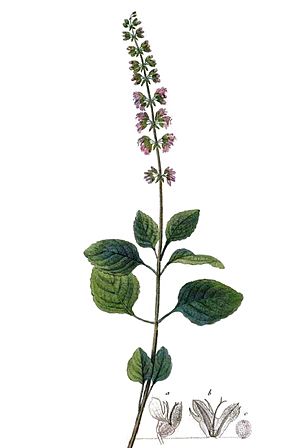Platostoma facts for kids
Quick facts for kids Platostoma |
|
|---|---|
 |
|
| Platostoma africanum | |
| Scientific classification |
|
| Kingdom: | Plantae |
| Clade: | Tracheophytes |
| Clade: | Angiosperms |
| Clade: | Eudicots |
| Clade: | Asterids |
| Order: | Lamiales |
| Family: | Lamiaceae |
| Subfamily: | Nepetoideae |
| Tribe: | Ocimeae |
| Genus: | Platostoma P.Beauv. |
| Synonyms | |
|
|
Platostoma is a group of flowering plants. These plants belong to the mint family, called Lamiaceae. Scientists first described this group of plants in 1818.
You can find Platostoma plants in warm, tropical areas. They grow naturally in parts of Africa, southern Asia, a region called Papuasia, and Australia. Some older names for these plants were Mesona and Acrocephalus.
One very popular type of Platostoma plant is Platostoma palustre. It has many local names like xiancao in Mandarin and cincau in Indonesian. People often eat this plant as a snack. It can be used in drinks or made into a jelly, known as grass jelly.
In Indonesia, people use the leaves of Platostoma palustre to make a black jelly. You can also buy an instant powder version to make it easily.
What Are the Different Kinds of Platostoma?
There are about 44 to 46 different accepted kinds, or species, of Platostoma plants. Here are a few examples:
- Platostoma africanum is found in tropical Africa, southern India, and some islands in Indonesia.
- Platostoma annamense grows in Vietnam, Thailand, and Cambodia.
- Platostoma calcaratum is found in southern China and northern Indochina.
- Platostoma cochinchinense grows in southern China, Indochina, Java, and Sumatra.
- Platostoma hispidum is found across Southeast Asia, southern China, Assam, and New Guinea.
- Platostoma palustre is widespread in Southeast Asia, southern China, Assam, Bangladesh, and New Guinea. This is the one often used for grass jelly!
- Platostoma rotundifolium grows in tropical and southern Africa.
Images for kids
See also
 In Spanish: Platostoma para niños
In Spanish: Platostoma para niños


